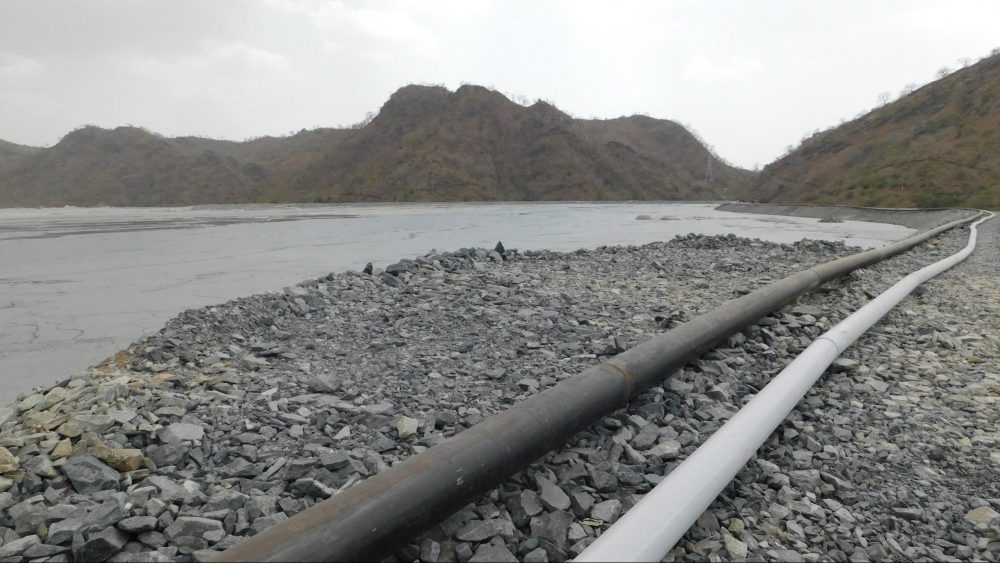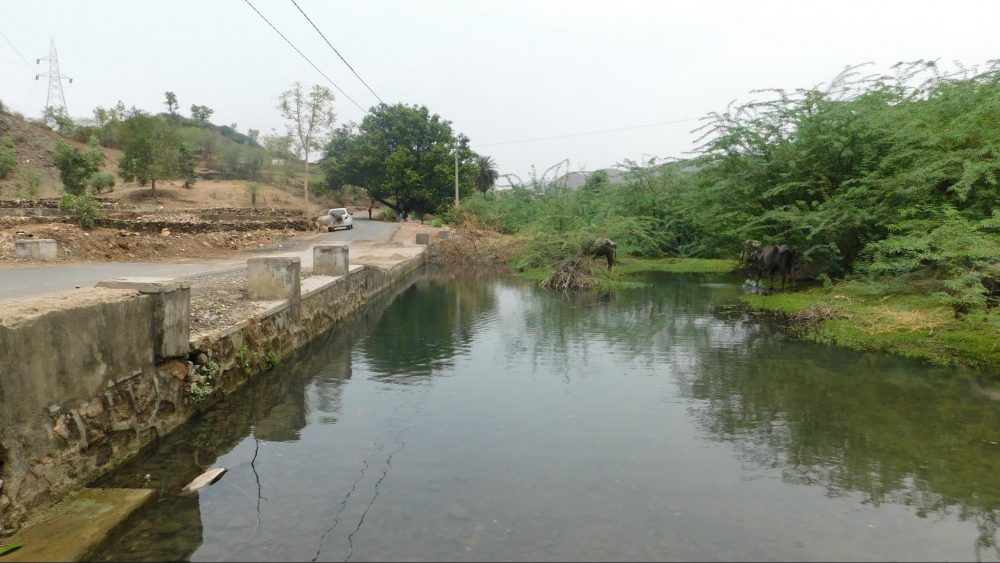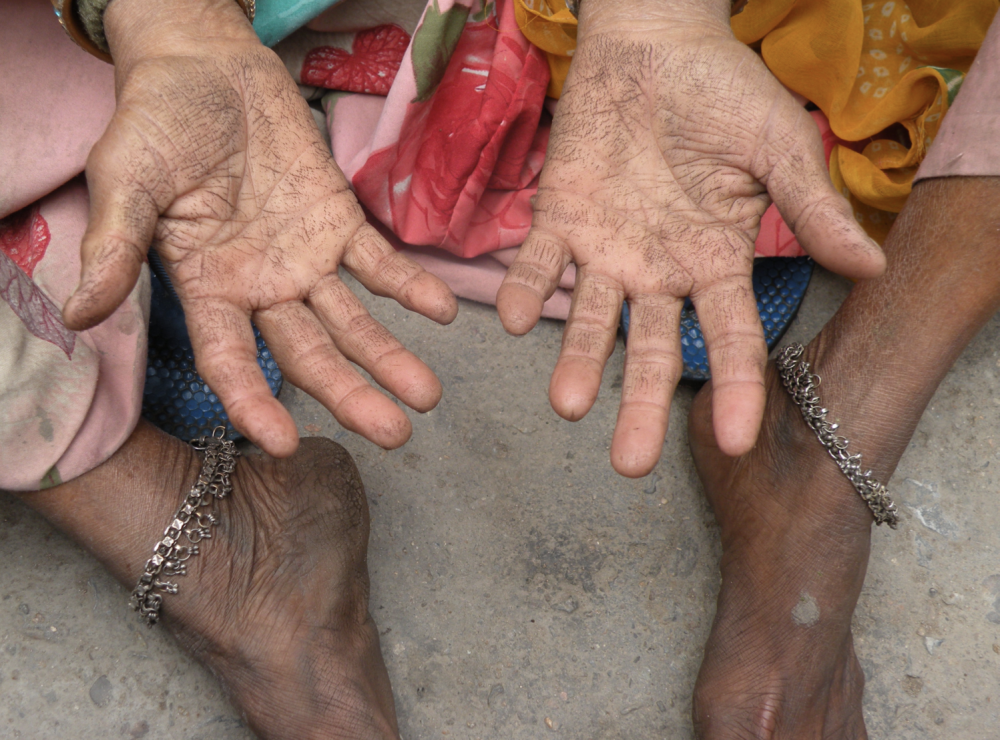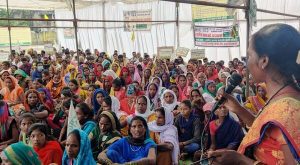Adivasi Women In Rajasthan’s Zawar Mines Reclaim Their Rights
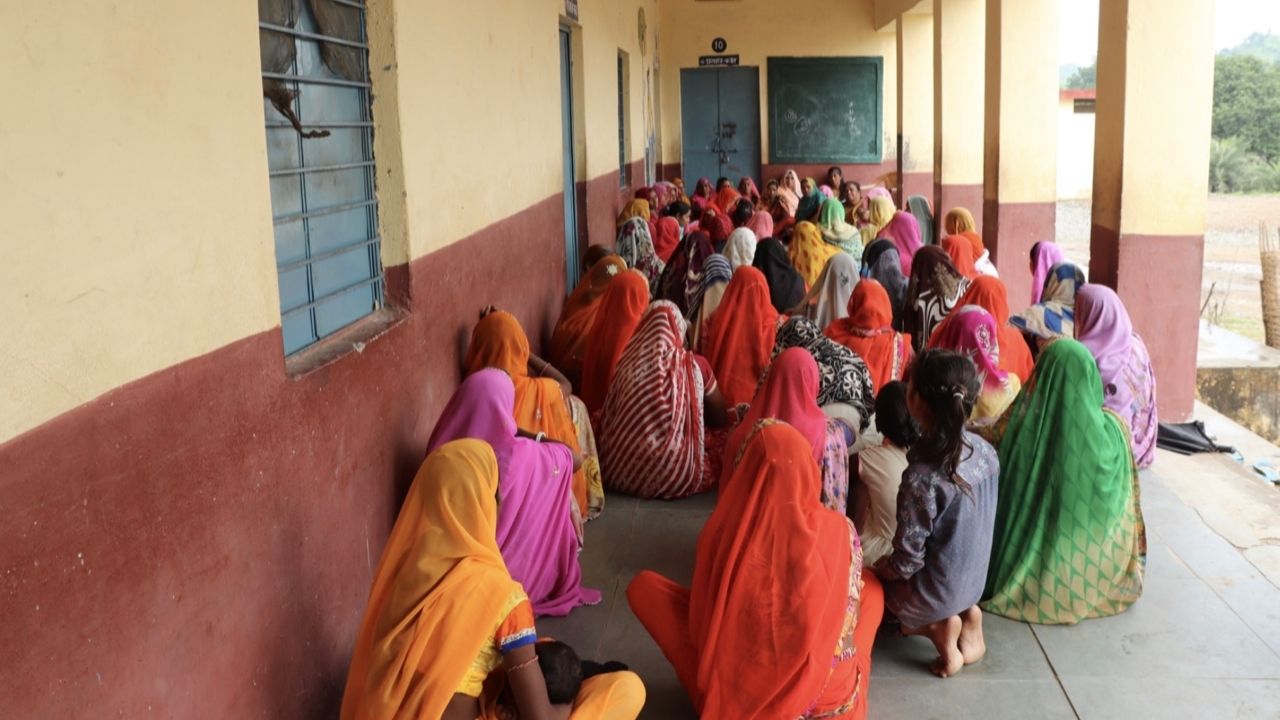
Lakshmi Devi (56), a Bhil Adivasi woman from Kanpur village in Udaipur district in Rajasthan has not been able to harvest a single grain from the 3kg of pulses she sowed on her 2 acre farm this year.
” Look at my field, it has completely dried up because there is no water in the wells or hand pumps for me to irrigate my crops. If there was water, I would have got a proper yield. Without any food or water, how are we to survive?”, she said.
Kanpur is a village located in the periphery of the Zawar mines, an underground zinc mining operation owned by Vedanta- Hindustan Zinc Limited in Udaipur district.
The mines have turned their water sources scarce and completely unfit for use, say the Adivasi residents of the surrounding villages. Most affected by the environment pollution caused due to the mines are women farmers, for whom agriculture is the main source of livelihood and sustenance.
Zawar mines are known to be one of the oldest zinc smelting sites in the world with sources dating its existence to the 13th century AD. Spread over an area of 3620 hectares, these mines are located in the fifth schedule area belonging to the Bhils and the Meena tribes of Udaipur district in Southern Rajasthan. Adivasi communities in the region depend on the Kewra reserve forests that surround the Aravali mountain range.
The mines, once owned by Hindustan Zinc Limited (HZL), a Public Sector Undertaking (PSU), were partly acquired by the Vedanta Group during the Government of India’s disinvestment drive in 2002. HZL is now a subsidiary of multinational company Vedanta Resources, which was registered with the London Stock Exchange (LSE). In October 2018, Vedanta Resources delisted from the LSE after farmers in Zambia who were affected by their operations registered a case against them in the Supreme Court of UK.
In 2017, the Ministry of Environment and Forests, gave an environment clearance for increasing the production capacity of Zawar mines from 1.5 million tonnes per annum (MTPA) to 4 MTPA for a period of 15 years after an Environment Impact Assessment (EIA) Report was submitted by Hindustan Zinc Limited in 2016. In June 2020, the company submitted another EIA report to the MoEFCC to obtain clearance for further expansion of the mines to 4.8 MTPA.
There has been a subsequent rise in environmental violations, with the expansion of mines over the past 5 years. This has further eroded the use of land and resources by the local Adivasi communities.
Adivasi women in the villages surrounding the Zawar mines have been mobilising to protect their natural resources and demanding liability from Vedanta- Hindustan Zinc Ltd for the damages they have suffered.
Impact of Mining on Adivasi Women around Zawar Mines
“ Earlier, when we switched on the motor, we had enough water to fill in our tanks. We used it for irrigation and household use”, recalled Kanta Bai (42), a farmer from Kanpur village around the Zawar mines.
“ Now, water does not reach even up to our fingers with so much mining underground. What we do get is sewage like water which damages our crops.Our wheat doesn’t grow anymore”, she said.
Such testimonies from the women farmers and residents of the villages around the mines contradict the claims made in the EIA report. Their voices remain unheard as women affected by mining who are not consulted during public hearing proceedings,
find themselves excluded from processes of environment decision making.
The recent introduction of the Draft EIA 2020 bill which seeks to dilute the process of EIA and public hearings will further reduce the space for women affected by mining to access information and articulate their concerns.
Hindustan Zinc Limited, in their EIA report submitted to the Ministry of Environment and Forests in 2016, claimed minimal environmental pollution since Zawar mines are an underground operation.
“No land degradation would take place on account of underground mining operations”, said the report. It further added that “ most of the dust produced during blasting will settle down underground and get diluted by ventilating air before being exhausted.”
This however doesn’t account for the interconnected linkage of ecosystems where the excavation and blasting processes followed in the underground mining has a subsequent impact on the ground water sources, topography of the land and soil quality in the region.
Underground mining processes have exhausted and contaminated the surface water (natural streams) and groundwater sources (handpumps, boring wells, tanks). As a semi-arid region with scant rainfall, these villages are already facing a severe water crisis.
The EIA report also fails to assess the water and air pollution caused by its overground operations such as the tailing dam and the captive thermal power plant which are located very close to two directly affected villages-Kanpur and Nevatalai.
The tailings dam, an embankment which stores a mix of crushed rock and processing fluids after extraction, is located on a hill right next to Kanpur village. Despite the community resistance, a new dam has been proposed next to the existing dam. The finer particles from the tailings dam are carried by the wind in the dry season and deposited on the agricultural fields increasing the salinity of the soil.
(Pipelines carrying mine waste to the tailings dam near Kanpur village. Photo Credit: Dhaatri Resource Centre for Women and Children’s rights)
The natural stream running through Kanpur and Padla villages which was once the main source of water for drinking and cooking purposes is now unfit for use by the community. The water was found to have high levels of cadmium and zinc during a water quality test organised by the residents of Kanpur in 2016.
(The contaminated stream that flows through Kanpur village which has been polluted due to the tailings dam nearby. Photo Credit: Dhaatri Resource Centre for Women and Children’s rights.)
“When we make chai with this water, the milk splits. Even dal doesn’t get cooked properly”
said Janki Devi (45), a resident of Kanpur village.
After agitation by the residents, Vedanta arranged for water tankers in Kanpur village. These tankers, however, are irregular and have only increased women’s burden of collecting water. This limited supply has meant that women have to ration their water usage for cooking, washing, cleaning and feeding of cattle.
(Thermal captive power plant in Nevatalai which provides electricity for the Zawar Mines was setup in 2016. Photo Credit: Dhaatri Resource Centre for Women and Children’s rights.)
Additionally, the fly ash from the 80 MW coal-fired captive power plant set up by Hindustan Zinc in the centre of Nevatalai village has left the entire village covered in black dust causing distress to the residents. Women complained that this black dust sticks on their bodies and comes out of their noses when they sneeze. Their water sources for consumption and irrigation have also turned black causing damages to their agriculture and health.
(Manju Devi standing next to her sick cow on her fields in Nevatalai village. Photo Credit: Dhaatri Resource Centre for Women and Children’s rights.)
Manju Devi is a 65 year old woman farmer whose 2 acre farm is located right next to the power plant, separated by a boundary wall. This boundary wall has pipes built into it from where the water that is used to wash the coal is regularly released on her field, turning it black and parched. In the past five years, her agriculture yield has reduced by over 80 percent of its original output. In the past two years, the corn she sowed on her field has completely dried up. With reduced crops from her own fields, she is forced to buy food from the open market.
Her cattle have lost all their hair and weight as a result of feeding on the toxic grass on her field. Due to increased cases of cattle sickness and death, women farmers are finding it hard to sustain their alternative source of livelihood through cattle rearing.
Unable to make any dairy products from the low-quality milk, women farmers find it difficult to provide adequate nutrition for their children. Their expenditures have also increased with increased veterinary costs of the sick cattle.
All this has led to women being caught in cycles of debt. Male members of their families are also forced to migrate after loss of jobs for local people in the mines, forcing many women to fend for their land and families on their own. Adivasi women farmers find their future even more uncertain.
Women And Children Suffer Health Issues
Women in the villages bordering the mines also suffer from skin infections, stomach issues, gynaecological complications and reported miscarriages. Due to work on the contaminated soil, women have painful blistered feet and rashes on the hands. Many of the children in the area are born with deformities, which community members say, are linked to high levels of zinc found in the water sources.
(A woman farmer’s blistered hands due to working in the contaminated fields. Photo Credit: Dhaatri Resource Centre for Women and Children’s rights)
Despite the health impacts of mining, the health facilities in the region are woefully inadequate. The only hospital built by Hindustan Zinc Limited in the Zawar mine township lies dysfunctional, with one nurse as the only staff on duty. Even then, the nurse only attends to general checkups for the staff working in the mines. Women however have to travel a distance of 40 kms to Udaipur city to access medical services.
Vedanta, through its CSR initiatives, have established model Anganwadis called ‘Nandghars’ and Self Help Groups (SHGs) under a program known as ‘SAKHI’ for the socio-economic empowerment of women in the villages around Zawar mines. Yet, these offer little space for women to discuss their issues and raise demands.
They do not recognise women as equal stakeholders whose health, livelihoods and food security has been directly affected by the mining operations.
Women Speak Out Against Vedanta
In 2017, Adivasi women from the villages affected by the Zawar mines started mobilising to air their grievances and concerns. With the support of a local woman human rights defender, who wishes to remain anonymous due to safety concerns, they sought to understand their rights, constitutional safeguards and laws that guarantee their self-determination.
These include laws such as PESA, Forest Rights Act , the Samata Judgement which guarantee the self determination of Gram Sabhas ( local elected village councils) and recognise their right to free, prior and informed consent in case of large scale infrastructure projects such as mining.
With a recognition of their legal rights, women from affected villages began to file complaints directly to the District Collector and others in the district administration. After a lack of response from the government, they chose to address their complaints to Vedanta directly.
(Affected women presenting their demands at the public gathering at the Vedanta headquarters. Photo Credit: Dhaatri Resource Centre for Women and Children’s rights)
Around 800 women from affected villages across several Panchayats gathered for a sit-in protest in front of the Vedanta office, on 5th February 2019, to demand redressal for the violations by their mining operations. They demanded restoration of groundwater sources, provision of irrigation facilities and repair of houses demolished by blasting. They also demanded employment for local people in the mines.
After this gathering, Vedanta- HZL constructed a pipeline and water tank in Kanpur village. However, women have reported that water supply continues to be irregular and the water from the pipelines is released only once a month.
“How can a pipeline or tanker provide us with relief when the entire groundwater has dried up? They have dug so deep below that they have interrupted the groundwater channels” says Sunita (37) an Adivasi woman farmer from Kanpur village.
Women in the affected regions have rejected these temporary measures that do not address the massive scale of the ecological destruction.
Women’s movement in the Zawar mines has demanded that any rehabilitation must take into account the rights of local communities over their existing natural resources on their land rather than relying on handouts offered by companies.
Intimidation of Adivasi Women
The public gathering was a historic moment for the women from the villages around Zawar mines however it was followed by a period of backlash and intimidation.
“In an area where community resistance has been curbed for quite a while, the mobilisation of Adivasi women certainly challenged the status quo on various levels. Political interlinkages have also divided the community between those who benefited from the mines and those made poorer because of it ”, said the local human rights defender.
These vested interests include local political representatives, contractors and other intermediaries who viewed this gathering as an attempt to challenge the mining operations.
Shortly after the gathering, a few local groups organised a smear campaign against the women and the local woman human rights defender accusing them of violence and destruction of property.
As Vedanta started to lay off local mine labour due to the mechanisation of the mines, women resisting against the company were blamed for the job losses. Women who are a part of the SHG federation were questioned about their involvement in the gathering by local NGOs who facilitate Vedanta’s CSR initiatives.
These slew of intimidations saw the movement scattered since it began.
DMF Ka Hissa Campaign
While the ongoing pandemic and the restrictions have made it harder for women to gather, they have come together to support each other in the time of crisis. Relief activities by the government and Vedanta remained out of reach for many single and widowed women.
With agriculture in the area being completely destroyed by mining, the limited access to food heightened their vulnerability. The local woman human rights defender has been working to provide seeds to the women farmers and connecting them to alternative sources of livelihood for their sustenance.
Women from the affected villages around the Zawar mines are now advocating for a proper rehabilitation of the damages they suffered due to underground zinc mining through the District Mineral Foundation (DMF) funds.
The DMF is a non-profit trust established in mining affected districts through an amendment of section 9(b) of the Mines and Minerals Development (and Regulation) Act in 2015. The fund is collected through a percentage of the royalty payments made by mining leaseholders. The allocation of funds and the membership of the DMF trusts are determined via rules made by State Governments. The mandate of the trust is to implement projects for the welfare and development of mining affected communities
In Rajasthan, the implementation of the DMF fund is overseen by a Governing Council, consisting of all MLAs of the district. An amendment passed by the Mines Department in Rajasthan on June 1st 2018 stated that MPs of districts would be included as trustees in the DMF governing councils.
Such a heavy political representation in the membership of the DMF Trusts restricts the space for mining affected communities, especially women, to be involved in the decision making and implementation of DMF projects.
(Adivasi women from villages around Zawar mines put up slogans for the ‘ DMF ka Hissa Campaign”. Photo Credit: Dhaatri Resource Centre for Women and Children’s rights)
Women in mining regions are now demanding their representation and voice in the fund allocation process of the DMF through a national campaign called ‘DMF ka Hissa’( share of DMF). As a part of this campaign, women affected by Zawar Mines have sent representations to the district collector demanding for livelihood support, groundwater restoration, clean-up of water bodies and setting up of health infrastructure with equipment for the treatment of mining illnesses and COVID-19.
One of the slogans they presented during the campaign said “ Hua pradushit mera pani, hua prabhavit mera svastha, kya mein DMF ka hissa hoon?” (My water got polluted and my health got impacted due to mines, am I included in DMF?)
Despite the challenges to their mobilisation, they continue to reclaim their rights and future from being destroyed by reckless mining activities. In the absence of spaces for their participation, Adivasi women have created their own spaces to demand for their right to life, livelihood and clean environment.
In doing so, they have challenged the patriarchies within their community, the company and the state by asserting their identities as equal stakeholders–as farmers, foragers, knowledge keepers and economic heads of their families.
[Vaishnavi Varadarajan is a Research Associate at Dhaatri Resource Centre for Women and Children’s rights- an NGO working on the intersection of gender and environment justice by supporting local campaigns led by adivasi and rural women to protect their natural resources, knowledge and culture]
We believe everyone deserves equal access to accurate news. Support from our readers enables us to keep our journalism open and free for everyone, all over the world.
